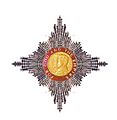Katharine Stewart-Murray, Duchess of Atholl facts for kids
Quick facts for kids
The Duchess of Atholl
|
|
|---|---|
 |
|
| Member of Parliament | |
| In office 6 December 1923 – 28 November 1938 |
|
| Preceded by | James Gardiner |
| Succeeded by | William McNair Snadden |
| Constituency | Kinross and West Perthshire |
| Personal details | |
| Born |
Katharine Marjory Ramsay
6 November 1874 Edinburgh, Scotland |
| Died | 21 October 1960 (aged 85) Edinburgh, Scotland |
| Political party | Scottish Unionist Party |
| Spouse | John Stewart-Murray, 8th Duke of Atholl |
| Parent | Sir James Henry Ramsay, 10th Baronet |
| Alma mater | Royal College of Music |
Katharine Marjory Stewart-Murray, Duchess of Atholl, also known as DBE, was an important Scottish noblewoman and politician. She was born Katharine Ramsay on 6 November 1874 and passed away on 21 October 1960. From 1899 to 1917, she was known as the Marchioness of Tullibardine. She was a member of the Scottish Unionist Party, but she often held views that were different from her party's.
Contents
Early Life and Education
Katharine Marjory Ramsay was born in Edinburgh, Scotland, on 6 November 1874. Her parents were Sir James Henry Ramsay and Charlotte Fanning Ramsay. She went to Wimbledon High School and later studied music at the Royal College of Music. During her school days, people called her Kitty Ramsay.
On 20 July 1899, she married John Stewart-Murray, who was then the Marquess of Tullibardine. In 1917, her husband became the 8th Duke of Atholl. At that point, she became known as the Duchess of Atholl.
Political Career and Public Service
Katharine, often called "Kitty," was very active in helping people in Scotland. She worked in social services and local government. In 1912, she was part of a very important group called the "Highlands and Islands Medical Service Committee." This committee helped create an early version of the National Health Service, which provides healthcare for everyone.
At first, Katharine was against women getting the right to vote in national elections. She was a main speaker at a big protest in Scotland in 1912 against women's suffrage. In 1913, she became a leader in a group in Dundee that opposed women's voting rights.
However, despite her early views, she later became a politician herself. In 1923, she was elected as a Member of Parliament (MP) for Kinross and West Perthshire. This made her the first woman to represent a Scottish area in the British Parliament. From 1924 to 1929, she worked as the Parliamentary Secretary to the Board of Education. She was the first woman in a British Conservative government to hold such a position.
Some people thought she got her seat in Parliament because of her husband. However, others disagreed, pointing out that her husband had left politics years before. Her victory in 1923 was not expected to be easy.
Katharine was known for standing up for what she believed in, even if it meant disagreeing with her own party. In 1935, she left her party's main group in Parliament because she disagreed with a new law about India and some of the government's policies. She rejoined for a while, but then left again in 1938. This time, she was against Prime Minister Neville Chamberlain's policy of trying to avoid war by giving in to Adolf Hitler's demands. She also opposed an agreement with Italy. Because of her strong opinions, her local party decided not to support her anymore. She then left Parliament and ran as an independent candidate in a special election, but she did not win.
She strongly opposed governments that controlled everything and did not respect people's rights. In 1931, she wrote a book called The Conscription of a People. In it, she protested against the lack of human rights in the Soviet Union. After reading Hitler's book Mein Kampf, she also spoke out against Nazi Germany. She even had public arguments with another woman, Lady Houston, who supported Benito Mussolini, a dictator in Italy.
In 1937, Katharine traveled to Spain with two other women MPs, Ellen Wilkinson and Eleanor Rathbone. They went to see how the Spanish Civil War was affecting people. She saw cities being bombed and visited prisoners. She also looked at how the war impacted women and children. Her experiences led her to write a book called Searchlight on Spain. She supported the side fighting against the Nationalists, which led some people to call her the Red Duchess.
After World War II, she continued to fight for freedom. She campaigned against the Soviet Union's control over countries like Poland, Czechoslovakia, and Hungary. In 1958, she wrote a book about her life with her husband called Working Partnership.
Other Contributions
Katharine was also a vice-president of the Girls' Day School Trust from 1924 to 1960. This organization helps run schools for girls. She was also a talented composer. She wrote music for poems by Robert Louis Stevenson. In 1927, she helped open a new part of Clifton High School, Bristol.
She was very involved with her husband's army regiment, The Scottish Horse. She even composed a melody called "The Scottish Horse" to be played on bagpipes.
Honours and Later Life
In 1918, she was given the honour of Dame Commander of the Order of the British Empire (DBE). This is a special award from the British monarch.
After her husband passed away, she became the Honorary Colonel of The Regiment of Scottish Horse in 1942. She held this position until 1952.
Katharine, Duchess of Atholl, passed away in Edinburgh in 1960, at the age of 85.
See also
- Duke of Atholl
- Julia Pirie
Images for kids


